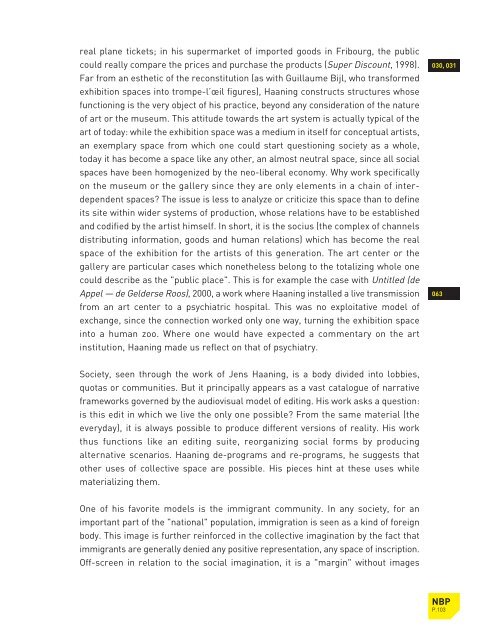download catalogue high resolution pdf (22.3 mb) - Jens Haaning
download catalogue high resolution pdf (22.3 mb) - Jens Haaning
download catalogue high resolution pdf (22.3 mb) - Jens Haaning
You also want an ePaper? Increase the reach of your titles
YUMPU automatically turns print PDFs into web optimized ePapers that Google loves.
eal plane tickets; in his supermarket of imported goods in Fribourg, the public<br />
could really compare the prices and purchase the products (Super Discount, 1998).<br />
Far from an esthetic of the reconstitution (as with Guillaume Bijl, who transformed<br />
exhibition spaces into trompe-l’œil figures), <strong>Haaning</strong> constructs structures whose<br />
functioning is the very object of his practice, beyond any consideration of the nature<br />
of art or the museum. This attitude towards the art system is actually typical of the<br />
art of today: while the exhibition space was a medium in itself for conceptual artists,<br />
an exemplary space from which one could start questioning society as a whole,<br />
today it has become a space like any other, an almost neutral space, since all social<br />
spaces have been homogenized by the neo-liberal economy. Why work specifically<br />
on the museum or the gallery since they are only elements in a chain of interdependent<br />
spaces? The issue is less to analyze or criticize this space than to define<br />
its site within wider systems of production, whose relations have to be established<br />
and codified by the artist himself. In short, it is the socius (the complex of channels<br />
distributing information, goods and human relations) which has become the real<br />
space of the exhibition for the artists of this generation. The art center or the<br />
gallery are particular cases which nonetheless belong to the totalizing whole one<br />
could describe as the "public place". This is for example the case with Untitled (de<br />
Appel — de Gelderse Roos), 2000, a work where <strong>Haaning</strong> installed a live transmission<br />
from an art center to a psychiatric hospital. This was no exploitative model of<br />
exchange, since the connection worked only one way, turning the exhibition space<br />
into a human zoo. Where one would have expected a commentary on the art<br />
institution, <strong>Haaning</strong> made us reflect on that of psychiatry.<br />
Society, seen through the work of <strong>Jens</strong> <strong>Haaning</strong>, is a body divided into lobbies,<br />
quotas or communities. But it principally appears as a vast <strong>catalogue</strong> of narrative<br />
frameworks governed by the audiovisual model of editing. His work asks a question:<br />
is this edit in which we live the only one possible? From the same material (the<br />
everyday), it is always possible to produce different versions of reality. His work<br />
thus functions like an editing suite, reorganizing social forms by producing<br />
alternative scenarios. <strong>Haaning</strong> de-programs and re-programs, he suggests that<br />
other uses of collective space are possible. His pieces hint at these uses while<br />
materializing them.<br />
One of his favorite models is the immigrant community. In any society, for an<br />
important part of the "national" population, immigration is seen as a kind of foreign<br />
body. This image is further reinforced in the collective imagination by the fact that<br />
immigrants are generally denied any positive representation, any space of inscription.<br />
Off-screen in relation to the social imagination, it is a "margin" without images<br />
030, 031<br />
063<br />
NBP<br />
P.103


